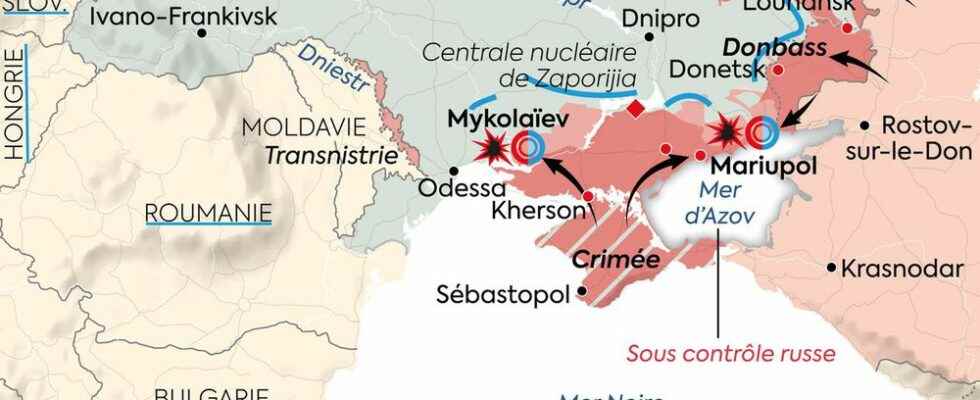The Blitzkrieg hoped for by Putin did not work, but the war is still far from over. A month into the invasion of Ukraine, the Russian military now appears to be favoring a campaign of airstrikes and heavy artillery shelling of cities. In the hollow of this war of attrition which promises to be as long as it is deadly, the question arises of the capacity of the Ukrainian forces to hold out in the long term in the face of Russian pressure.
“We see that on certain parts of the front, particularly in the north, the Russian forces are in the process of fortifying their positions and digging trenches, underlines Elie Tenenbaum, director of the center for security studies at the French Institute for International Relations. (Ifri). The objective is to hold on to their territorial gains, keep up the pressure, and potentially find time to reorganize before relaunching an offensive when they have regenerated their forces.”
Despite the fierce resistance of the Ukrainian forces, Moscow does not seem to have lowered its strategic objectives. If Ukrainian President Volodymyr Zelensky said he was ready on Tuesday to discuss with Vladimir Putin a “compromise” on Donbass and Crimea to end hostilities, the Kremlin, inflexible, retorted that the ongoing talks with kyiv were not “substantial” enough.
Threat of encirclement in the Donbass
For the time being, Moscow is concentrating its efforts in the south, where, contrary to the relative stagnation of the northern front, the Russian army has won some successes by managing to take control of the cities of Kherson and Melitopol. Bringing down the strategic port of Mariupol – surrounded and heavily bombarded – as quickly as possible now appears to be a priority objective.
“The Russians want to reduce all the military resistance in the city, so that they can then launch a push north without having to fight on their backs, indicates Olivier Kempf, director of the strategic cabinet La Vigie, and associate researcher at the FRS The objective could be to operate a junction with the Russian forces located in the north, in order to encircle, in a pincer maneuver, the Ukrainian troops who are massively present in the Donbass.
Dario Ingiusto / L’Express
A situation that would de facto cut off the large Ukrainian military presence in the area from the rest of the country, depriving it of supplies at the same time. “When you are surrounded, you have to hold on to your reservations. It can last, but in the end, you find yourself in an increasingly precarious position”, slips Olivier Kempf.
Especially since in parallel, the Russians are working to destroy the Ukrainian defense industry. The Antonov aircraft and Artem armaments factories were both targeted by Russian airstrikes near kyiv last week. At the same time, an aircraft repair shop was also destroyed in Lviv, while the hypersonic missiles used for the first time by Moscow a few days later targeted a Ukrainian army ammunition depot in the west of the country, and a fuel reserve in the south.
Decisive Restocks
Well aware of the risk of depletion of military resources, the chief of staff of the Ukrainian president called on Tuesday evening the West to increase their arms deliveries. “Our armed forces and our citizens are holding on with superhuman courage, but we cannot win a war without offensive weapons, without medium-range missiles, which can be a means of deterrence”, he hammered in a video published on Telegram. On paper, the budget of the Russian army ($61 billion in 2020) remains 10 times higher than that of its Ukrainian neighbor.
After Volodymyr Zelensky’s speech to the US Congress last Wednesday, Joe Biden announced the sending of $800 million in additional military aid to kyiv. The delivery includes Russian surface-to-air missile systems, 100 so-called “kamikaze” drones, 800 “Stinger” anti-aircraft defense systems, 9,000 anti-tank systems, around 7,000 light weapons and 20 million munitions.
“The material reserves of the Ukrainian forces are much weaker than those of the Russian army. Their ability to replenish supplies from their Western support will therefore play a decisive role in the long-term combat that is coming,” judge Elie Tenenbaum. For the moment, morale does not in any case give the feeling of weakening in the population. According to a survey Rating Group published on Sunday, 93% of Ukrainians believe in their ability to repel the Russian invasion. In addition, 77% believe that the situation is moving in the right direction.
If the human toll remains questionable in times of war, the Russian army seems to pay the heaviest price. According to American estimates, more than 7,000 Russian soldiers died in three weeks. For his part, Volodymyr Zelensky indicated on March 12 that Ukrainian casualties amounted to “about 1,300” among the military. “We are entering into a war of attrition, which will last, until one of the two can no longer hold out”, concludes Olivier Kempf. Sanctions against Russia will also enter into the equation.
